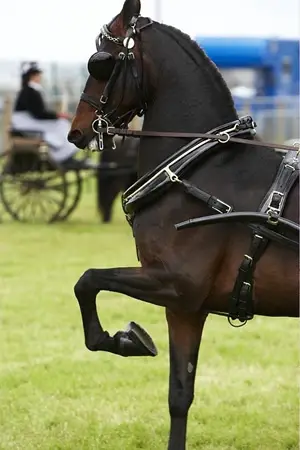History
The Hackney is a dynamic, high-stepper with two branches -- the horse and the pony -- both bred specifically for their brilliant performance in harness.
The Hackney horse was developed in Great Britain in the early 18th Century from the Darley Arabian through his son, Flying Childerns, foaled in 1715, and grandson, Blaze, a renowned British Thoroughbred foaled in 1733.
The Thoroughbred blood was crossed with the British native Norfolk Trotters of East Anglia and eastern Yorkshire through a sire called Jary's Bellfounder, a trotting horse which also is credited with passing on his bloodlines to the Standardbred. This created a fine, light horse with much style and spirit, which was favored as a carriage horse by English sportsmen and aristocrats.
The Hackney pony was developed from the Hackney horse by crossing with the small, spirited Welsh Ponies. The first well-known pony-type Hackney was Sir George, foaled in 1866. Sir George had strong bloodlines from the Norfolk Trotters. In England in 1872, the trend began to breed specifically for a pony type, but today the British breeders are not as particular about the size of the horses as are Americans, the priority being that the horse perform.
The Hackney was being imported to the United States from England by the late 1800's. It was in this time that the breeding to achieve the specific pony type was begun through crossing the Hackney horse with ponies of good conformation and motion. Today 95% of all registered Hackneys in the United States are ponies.
Although the Hackney horse had been imported to the United States for over 75 years, the Hackney pony was imported heavily to the U. S. beginning in 1872 with Stella 239. Many stallions which were highly influential in Britain in developing the ponies were brought to America either in the middle of their siring careers or for a few years before being taken back to England. There were also a number of stallions bred in America and later sent to England. For this reason, British and American ponies are more closely bred than some other breeds. Among those sires are Irvington Autocrat 1914, Southworth Swell 2175 and Paddock Lane's Robin Rea 2474. The strongest influence seems to have come from Southworth Swell, imported in 1925 by J. Macy Willets of Cassilis Farm. Most Hackney ponies today have his bloodlines in their pedigree.
In 1883 the English Hackney Horse Society was created to preserve and develop the integrity of the Hackney lines. The first annual show was held by the society in 1885 in London. In 1891, the American Hackney Horse Society was formed.
The name "Hackney" comes from the French word Hacquenee derived from the Latin word for horse, equus. The term, brought to England by the Normans in the 11th century, was fully assimilated into the English language by 1303. At that time the term meant a riding horse, as distinguished from the heavier warhorse, and later evolved to the abbreviated "Hack" meaning a riding horse or a hired carriage. The modern Hackney breed took only its name from Medieval times as it is rarely ridden because its conformation and extreme motion make it rough to ride. When crossed with modern Thoroughbreds, however, Hackneys have produced some excellent jumpers.
Since the development of the automobile eliminated the demand for carriage horses for transportation, the most popular use of the Hackney has been in the show ring. Hackneys are shown almost exclusively in harness (singly, in pairs, or in tandem), but they may be shown in hand, (lead by a person on the ground).






